Top 10 Things to Love About Letterman’s Top Ten Lists
10. Their topicality 9. Their absurdity 8. Their longevity 7. Their irreverence 6. Their silliness 5. Their brevity 4. Their self-deprecation 3. Their surprise 2. Their reliability 1. Regis.
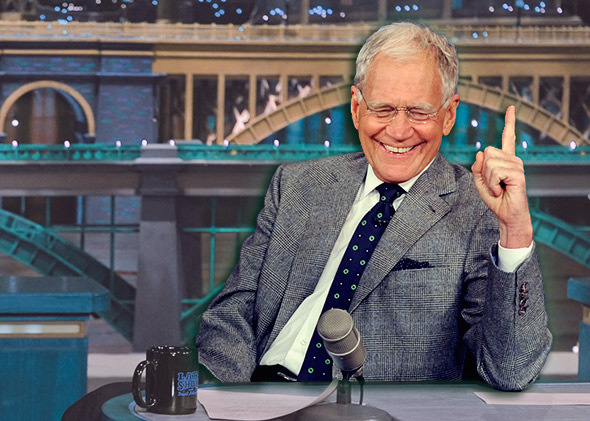
Photo illustration by Slate. Photo courtesy of CBS Photo Archive
Most jokes have the same basic structure: a setup that establishes a premise, followed by a punch line, which upends that premise with an unexpected twist or subversive turn. But not every comedy bit follows this two-beat format. For 29 years, David Letterman has been delivering his punch lines by the tens, in the now hallowed form of the Letterman Top Ten List. All of his lists take the same approach: one setup (“Top Ten Things Overheard at the White House Easter Egg Hunt”) followed by 10 punch lines (“One of the kids found a pair of Clinton's pants.”). It’s a high-wire joke-writing act: One decent punch line is hard enough. Delivering 10 good ones five nights a week for three decades is another thing entirely.
In May, when Letterman steps down and hand the reigns of the Late Show to Stephen Colbert, the Top Ten List will likely retire with him. Before Letterman counts down for the last time, I wanted to commemorate one of the longest running comedy routines in late-night history by trying to learn more about its inner workings: how it’s crafted, how it comments on our culture and politics, and how it’s evolved since the mid-1980s. How do Letterman’s writers start a list, and how do they end one? What kind of jokes work best in the Top Ten format? What kind of jokes don’t work at all? Which political figures have found their way onto the list most often? And what’s with all the Regis references?
To answer these questions, I performed a statistical analysis of every Top Ten List ever read on the air by Letterman. There is no single archive of all the lists, so I compiled my own from four different data sources containing more than 4,100 lists (and 41,000 entries) from September 1985 to September 2014. While confirming the accuracy of all the lists is impossible (for many of the years, no official transcriptions are available, so I was forced to rely on the records of die-hard fans), I believe my data set is a complete listing of all Top Ten Lists for this 29-year period, or about as close as you can get without working for the show.
Once I assembled my archive, I began analyzing the data, and patterns started to emerge. Much of late-night humor relies on mocking the people in the current headlines, and the Top Ten List is no exception. But over the years, I noticed that certain celebrities found their way onto the Top Ten more often than others, and not always because their names were in the news. Let’s take a look at the top 10 celebrities mentioned in Letterman’s Top Ten Lists:
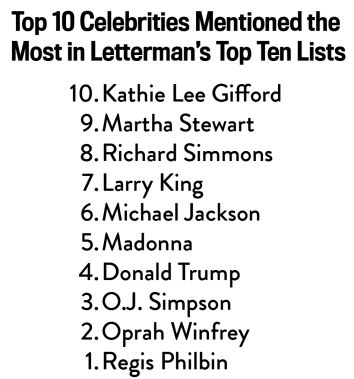
It’s clear why the likes of Donald Trump and Michael Jackson make this list. Trump has been delivering an endless stream of controversial business deals, abortive political forays, and general nonsense for decades. In life, and in death, few could match Michael Jackson’s tabloid appeal.
But why does Regis hold the top spot in this list? How is it possible that the unremarkable talk show host is the most mocked man in Letterman’s long career? Sure, he’s a frequent guest on the show, but he’s not an A-list celebrity. He’s never been involved in a major scandal. He’s not someone who gets name-checked abundantly on other comedy shows. How did Regis become one of the longest running inside jokes in the history of late-night comedy?
I shared the results of my Top Ten number-crunching with Joe Toplyn, who wrote for Late Night With David Letterman from 1983 to 1990 and for the Late Show With David Letterman from late 1995 to 2001 (including a stint as head writer from 1995-1996); he’s also the author of the recent book Comedy Writing for Late-Night TV. I wanted to get a sense if the trends I was noticing tracked with his experience assembling and editing the nightly lists. His explanation for why Regis ended up on so many lists was simple: Letterman writers write jokes they think Letterman will like. Toplyn postulated that at some point in list history, writers realized the Regis jokes were getting chosen by Dave and subsequently getting laughs from the audience … so writers kept writing them.
The first mention of Regis was in “Top Ten Lies We Tell Our Guests,” a list from the Late Night era. He appears at No. 7: “We invited you here because we’ve wanted to have you on for a long, long time and not at all because our other guests canceled and we’re really desperate, Regis.” Since then, Regis has returned again and again, often in the role of a lonely nuisance or befuddled geezer.
Click the “Random Regis Generator” below to read a Top Ten List entry that mentions Regis Philbin.

Toplyn had another theory as to why Regis jokes work so well. Regis is funny because the word Regis just sounds funny. Some words are just funnier than others, and the Top Ten List, which must pack 10 jokes into a relatively small space, privileges words that bring their own comedy. In addition to Regis, Toplyn told me I should look at the frequency of the words pants and ass, both of which Letterman and his writers consider inherently amusing words, nearly guaranteed to deliver a laugh. (Letterman even named his production company “Worldwide Pants Inc.”)

In the Corpus of Contemporary American English (a large sample of language drawn from fiction, newspapers, and academic texts), ass and pants are the 4,242nd and 2,713th most popular words, respectively. In the Top Ten canon, ass ranks as the 139th most popular word (just ahead of should), and pants ranks at 170th (just ahead of because). If you remove parts of speech (like prepositions and pronouns) and proper names (like Regis), ass even makes the top 10 nouns used in the Top Ten Lists:
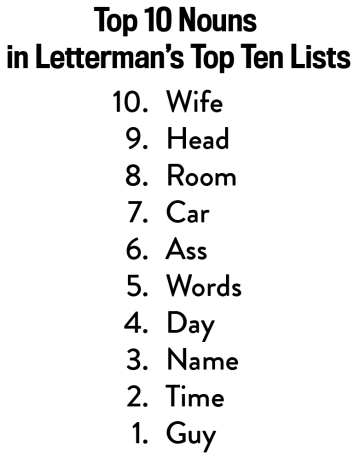
Students of Letterman’s lists have surely noticed over the years that there’s something special about the No. 1 slot in the list; it’s designed to be the funniest of them all, a kind of punch line to all the punch lines. Consider the list below, delivered in 1993. The final entry has both a Regis mention and the word ass. (The list also features Oprah, Madonna, Richard Simmons, and Kathie Lee—five of Letterman’s top 10 favorite celebrities.)
“Top Ten Disturbing Examples of Violence on TV”
10. The constant slapfights between Dan and Connie.
9. The day an obviously drunk Jacques Cousteau beat up a manatee.
8. Bob Barker’s quickie neuterings at the end of The Price is Right.
7. In special episode of Family Matters, everyone gets stranded on an island and Urkel is killed for meat.
6. Unknowing guest gets between Oprah and the buffet.
5. Disgruntled postal worker week on Jeopardy!
4. In Madonna Live Down Under, backup singer is impaled on a cone bra.
3. Malfunctioning Thighmaster beheads Suzanne Somers.
2. Richard Simmons tries to hug a fat guy who knocks him unconscious with a 2-by-4.
1. Kathie Lee kicks Regis in the ass.
Or consider this list, from 1990, which ends on a pants joke:
“Top Ten Things That Will Get You Kicked Out of the Macy’s Parade”
10. Every time a float goes by, scream at the top of lungs: “She's gonna blow!”
9. Asking total strangers if you can sit on their shoulders.
8. Going up on Macy’s roof; “fishing” for Willard’s toupee.
7. Throwing hotel keys onto float with Little Bo Peep.
6. Rubbing Kermit balloon on Al Sharpton’s hair; sticking it on the Chrysler Building.
5. Cold-cocking Santa; taking his place dressed as Roy Orbison.
4. Entering your own float: The life-size beat-up Camaro with 15 dudes crammed in it.
3. Taking a leak off the side of the reviewing stand.
2. Go on and on about how much better the Sears Thanksgiving Day parade is.
1. Marching pantsless.
Notice that not only does the list end on a pants(less) joke, but that final joke is also the snappiest of them all. At just two words long, it is far shorter than the other jokes in the list by at least seven words. This is another pattern I noticed: The final joke in a Top Ten List tends to be the shortest one. In his book, Toplyn emphasizes the importance of having a concise final entry: “Entry #1 should ideally have a quality of summation and finality to it,” he writes, and warns of making the final item too “long” or “specific.”
Here’s a breakdown of where the shortest jokes land on the list:
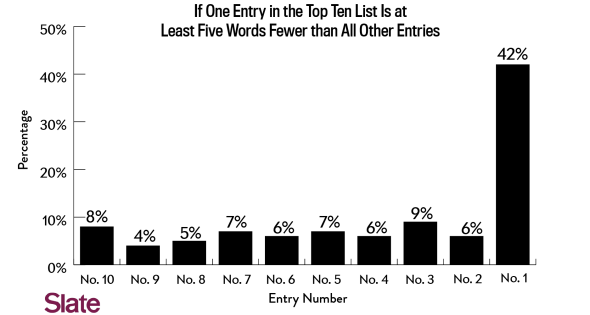
Chart by Ben Blatt
Like many routines on late-night television, the Top Ten List frequently relies on the news to propel it forward, and one type of news in particular: political news. Below is the list of the top 10 most commonly named political figures (whether American politicians or foreign leaders):
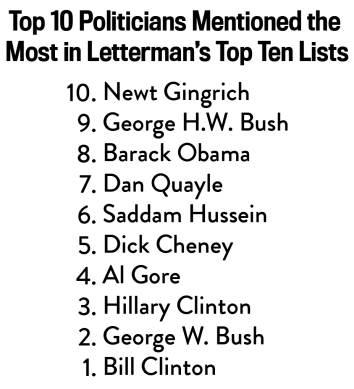
It stands to reason that Bill Clinton owns the top slot. Even if a certain incident in the Oval Office had not taken place, he had the benefit of being president for eight years during Letterman’s tenure, and unlike fellow two-termer George W. Bush, he remained in the limelight after his presidency, due to Hillary Clinton’s political career. But longevity is far from the sole factor in making the list—some politicians are just more fun to skewer than others. Notice that George H.W. Bush is outpaced by his vice president, the easy target Dan Quayle.
Toplyn believes that what made Clinton such a good target was that the entire Letterman audience understood the premise of jokes about him, and, importantly, Clinton’s foibles (his overeating, his philandering) were of a type you could laugh at safely. “A mass audience won’t let you joke about certain topics,” Toplyn writes. “Many topics are so tragic, disturbing, or offensive that the negative emotions they bring out in most people tend to overwhelm the urge they have to laugh.” Clinton’s losing war on his appetites was less controversial than, say, Bush’s war on terror.
Click the Random McClinton Generator below to read a Top Ten List entry that mocks Clinton’s fondness for the Golden Arches.

Indeed, in the aftermath of the Sept. 11 attacks, the Top Ten List became a politics-free zone for far longer than you might remember. The night the show returned to the air, on Sept. 17, 2001, the approach was absurdist and completely off the news: “Top Ten Things That Almost Rhyme With Hat.” (The No. 1 entry: “ass.”)
In the days that followed, the lists featured other benign themes such as “Top Ten Least Popular Theme Restaurants,” “Top Ten Reasons I, Dave, Love Candy,” and “Top Ten Ways to Describe Bacon.” It wasn’t until Nov. 1, 2001, that the list returned to political satire with “Top Ten Things That Will Get You Thrown Out of the Taliban.”
Even the O.J. Simpson case, which we may recall as being fodder for endless late-night wisecracking, was handled gingerly, at first, by Letterman and his writers. Nicole Brown Simpson and Ronald Goldman were murdered in June 1994, the infamous Ford Bronco chase occurred five days later, and the jury selection in O.J. Simpson’s trial began in November 1994. But Simpson received just one mention in all of 1994’s Top Ten Lists. In the list “Top Ten Surprising Facts About the Average American,” the case appeared in entry No. 3: “Has been rejected from the Simpson jury three times.”
Even through the beginning of 1995, the Simpson references were few. The trial started on Jan. 24, 1995, but there wasn’t a mention of it until late February. It wasn’t until Letterman’s rival Jay Leno started making hay of the Simpson trial that Letterman followed suit. (Toplyn, at the time a writer for the Tonight Show, pointed out that even when Leno began making Simpson jokes, he tended to stick to secondary figures in the trial: Kato Kaelin, F. Lee Bailey, Marcia Clark.)
Around March, however, with the country riveted by the trial, the Simpson references started showing up in the Top Ten Lists in droves. Between March 1995 and February 1997, Simpson was mentioned more times than any other celebrity. Below is an interactive that shows the top 10 most mentioned celebrities or political figures by year. Letterman’s Simpson strategy appears to have been similar to Leno’s: In 1995, Simpson, Kaelin, Bailey, and Clark all made the cut.
Of course, no matter who is in the news, there are certain Top Ten tropes that crop up again and again—setups and structures the writers can’t help returning to. In his book, Toplyn lists what he considers to be the canonical “List Angles.” For example, in “Top Ten Signs You’re in Love With Oprah” the angle is “Signs.” Other common angles include “Excuses for” and “Things Overheard.”
I made a list of the Top Ten angles, based on my data set:
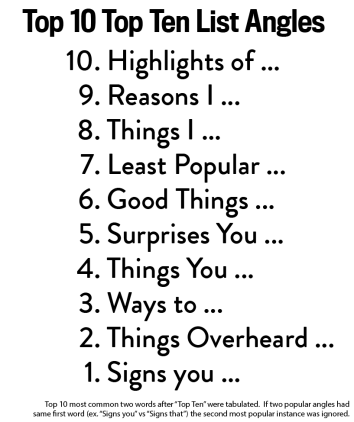
One of the rarest angles is “Things That Almost Rhyme With”; other than the post-Sept. 11 appearance, it’s only ever been used one other time—in the first ever list, delivered in 1985: “Top Ten Words That Almost Rhyme With ‘Peas.’ ” Below is an example of the far more frequently used “Things Overheard” angle from Dec. 17, 2002:
“Top Ten Things Overheard at the Late Show Christmas Party”
10. “Can we go now?”
9. “Attention: Please wash your paper plates and return them to the supply closet.”
8. “Can we go now?”
7. “OK, that comes to $17 a person.”
6. “Hey, it’s 11:30—turn on Leno.”
5. “Is it OK to take Lipitor with whiskey?”
4. “For the love of God can we go now?”
3. “Christmas party? Sorry, Mr. Philbin—don't know anything about a Christmas party.”
2. “Do you want to throw in five bucks for the intern fight?”
1. “Why is Letterman here?”
I chose this one not because the last entry is the shortest—though at four words, it is tied for that distinction. And not because it mentioned Letterman’s favorite television persona—though Regis makes an appearance at No. 3. I chose it because the final laugh is made at Letterman’s expense.
David Letterman has long relished self-deprecating humor. Along with his anti-humor, it’s one of his defining comic traits. My list of celebrities above excluded Letterman himself from the tally. When we include the host, he goes right to the top of the list. What’s more, if you make a list of the most mentioned people in Top Ten List history, including celebrities and politicians, Letterman tops that chart as well:
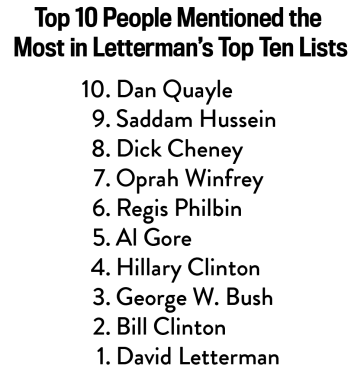
When Letterman ends his run, the comedy world will be waiting to see how he counts down a final time. Will he use the “almost rhymes with” angle, which seems to have sentimental value to him? Or will he do a compilation, such as his “Top Ten Top Ten List Entries From the Past 20 Years,” which he presented on the Late Show’s 20th anniversary last year (and filled with entries that had never actually appeared in one of the show’s lists). The final entry that night was the punchy “Clintern,” but the seventh was the most Letterman-esque of all: “A Regis tattoo right in the middle of your ass.”